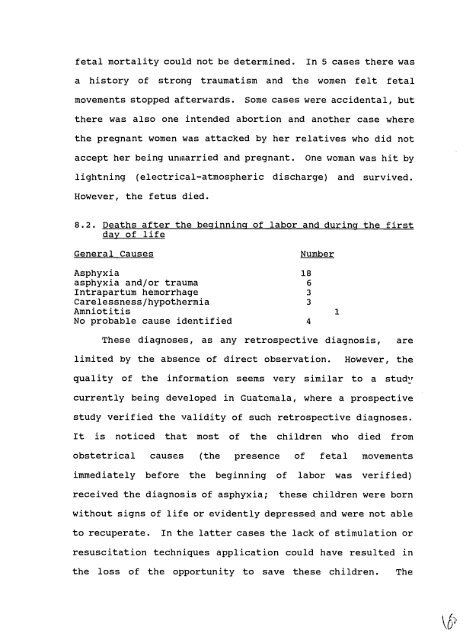MotherCare
MotherCare
MotherCare
You also want an ePaper? Increase the reach of your titles
YUMPU automatically turns print PDFs into web optimized ePapers that Google loves.
fetal mortality could not be determined. In 5 cases there was<br />
a history of strong traumatism and the women felt fetal<br />
movements stopped afterwards. Some cases were accidental, but<br />
there was also one intended abortion and another case where<br />
the pregnant women was attacked by her relatives who did not<br />
accept her being unmarried and pregnant. One woman was hit by<br />
lightning (electrical-atmospheric discharge) and survived.<br />
However, the fetus died.<br />
8.2. Deaths after the beQinning of labor and durinQ the first<br />
day of life<br />
General Causes<br />
Number<br />
Asphyxia<br />
asphyxia and/or trauma<br />
18<br />
6<br />
Intrapartum hemorrhage<br />
Carelessness/hypothermia<br />
3<br />
3<br />
Amniotitis<br />
1<br />
No probable cause identified<br />
4<br />
These diagnoses, as any retrospective diagnosis,<br />
are<br />
limited by the absence of direct observation.<br />
However, the<br />
quality of the information seems very similar to a study<br />
currently being developed in Guatemala, where a prospective<br />
study verified the validity of such retrospective diagnoses.<br />
It is noticed that most of the children who died from<br />
obstetrical causes (the presence of fetal movements<br />
immediately before the beginning of labor was verified)<br />
received the diagnosis of asphyxia;<br />
these children were born<br />
without signs of life or evidently depressed and were not able<br />
to recuperate. In the latter cases the lack of stimulation or<br />
resuscitation techniques application could have resulted in<br />
the loss of the opportunity to save these children.<br />
The

















